Thermal Management in 500 kV Oil-Immersed Converter Transformers: Synergistic Investigation of Critical Parameters Through Simulation and Experiment
Abstract
1. Introduction
2. Theoretical Analysis of Oil-Immersed Transformer Loss and Heat Transfer Process
2.1. Loss Analysis
2.2. Heat Transfer Process Analysis
- Quasi-static electromagnetic field: Displacement currents neglected (∂D/∂t ≈ 0);
- Incompressible flow: Density variations governed by Boussinesq approximation;
- Isotropic materials: Uniform thermal/electrical properties in all directions;
- Local thermal equilibrium: No temperature lag between solid and fluid phases.
3. Modeling and Analysis of Oil-Immersed Transformer Flow-Heat Coupling
3.1. Simulation Modeling and Initial Condition Setting
- (a)
- The ambient temperature of the oil tank is maintained constant at 25 °C.
- (b)
- The surfaces are assumed to be smooth, with friction between the transformer oil and solid surfaces neglected. Thermal resistance at the contact interfaces is also ignored.
- (c)
- The heat load from losses is uniformly distributed near the windings.
- (a)
- Inlet and Outlet Boundary Conditions: “Inlet” and “Outlet” boundary conditions are applied at the entrance and exit of the cooling fluid, respectively.
- (b)
- Wall Boundary Condition: The “No-Slip” boundary condition is used at the interface between the fluid and solid surfaces, indicating zero fluid velocity at the walls, which is consistent with the basic assumptions.
- (c)
- A “Heat Flux” boundary condition is applied on the transformer surface or windings to represent heat input or output per unit area.
- (d)
- The “Convective Heat Flux” boundary condition is applied at the interface between the transformer surface and the fluid, specifying the convective heat transfer coefficient and fluid temperature.
3.2. Analysis of Preliminary Simulation Results
4. Analysis of the Effect of Different Parameters on the Distribution of Flow and Temperature Fields of Oil-Immersed Transformers
4.1. Effect of Inlet Flow Rate on Heat Transfer Characteristics
4.2. Influence of Oil Pipe Radius on Heat Transfer Characteristics
4.3. Effect of Turn Spacing of Main and Secondary Windings on Heat Transfer Characteristics
4.4. Weighting Analysis of Multifactor Indicators
5. Simulation and Experimental Study of Temperature Rise in Oil-Immersed Converter Transformer
5.1. Modeling and Simulation of Oil-Immersed Converter Transformers
5.2. Temperature Measurement Pickup Point Situation
5.3. Typical Position Temperature Measurement Results
5.4. Temperature Measurement Pickup Point Results
6. Conclusions
Author Contributions
Funding
Data Availability Statement
Conflicts of Interest
References
- Jovcic, D.; Ooi, B.T. Developing DC Transmission Networks Using DC Transformers. IEEE Trans. Power Deliv. 2010, 25, 2535–2543. [Google Scholar] [CrossRef]
- Liu, G.; Hu, W.; Hao, S.; Gao, C.; Liu, Y.; Wu, W.; Li, L. A fast computational method for internal temperature field in oil-immersed power transformers. Appl. Therm. Eng. 2024, 236, 121558. [Google Scholar] [CrossRef]
- Sayed, S.; Massoud, A. Optimal power flow in multi-terminal HVDC networks with embedded high-power DC–DC converters for voltage matching and flexible DC transmission. IET Gener. Transm. Distrib. 2020, 14, 3866–3876. [Google Scholar] [CrossRef]
- Tao, J.; Zhan, H.; Luo, C.; Hu, S.; Duan, X.; Liao, M. Diffusion Properties of Gas Molecules in Oil–Paper Insulation System Based on Molecular Dynamics Simulation. Energies 2024, 17, 3811. [Google Scholar] [CrossRef]
- Seddik, M.S.; Shazly, J.; Eteiba, M.B. Thermal Analysis of Power Transformer Using 2D and 3D Finite Element Method. Energies 2024, 17, 3203. [Google Scholar] [CrossRef]
- Seddik, M.S.; Eteiba, M.B.; Shazly, J. Evaluating the Harmonic Effects on the Thermal Performance of a Power Transformer. Energies 2024, 17, 4871. [Google Scholar] [CrossRef]
- Hao, Y.; Zhang, Z.; Xiao, J.; Zhao, H.; Yang, Y.; Dong, Z. Study on Thermal Characteristics of Winding under Inter-Turn Fault of Oil-Immersed Transformer. Electronics 2024, 13, 2869. [Google Scholar] [CrossRef]
- Gao, C.; Gao, J.; Shi, H.; Zhao, X.; Wang, K.; Zhang, S.; Qi, B.; Li, C. Evolution laws of charge mobility of transformer oil and pressboard material with temperature and electric field strength. J. Phys. D Appl. Phys. 2025, 58, 055501. [Google Scholar] [CrossRef]
- Eteiba, M.B.; Aziz, M.M.A.; Shazly, J.H. Heat conduction problems in gas cooled-insulated power transformers solved by the finite-element method. IEEE Trans. Power Deliv. 2008, 23, 1457–1463. [Google Scholar] [CrossRef]
- Allahbakhshi, M.; Akbari, M. Heat analysis of the power transformer bushings using the finite element method. Appl. Therm. Eng. 2016, 100, 714–720. [Google Scholar] [CrossRef]
- Duan, X.; Zhao, T.; Liu, J.; Zhang, L.; Zou, L. Analysis of Winding Vibration Characteristics of Power Transformers Based on the Finite-Element Method. Energies 2018, 11, 2404. [Google Scholar] [CrossRef]
- Taheri, S.; Gholami, A.; Fofana, I.; Taheri, H. Modeling and simulation of transformer loading capability and hot spot temperature under harmonic conditions. Electr. Power Syst. Res. 2012, 86, 68–75. [Google Scholar] [CrossRef]
- Olowu, T.O.; Jafari, H.; Moghaddami, M.; Sarwat, A.I. Multiphysics and Multiobjective Design Optimization of High-Frequency Transformers for Solid-State Transformer Applications. IEEE Trans. Ind. Appl. 2021, 57, 1014–1023. [Google Scholar] [CrossRef]
- Feng, X.; Zhang, D.; Zhao, T.; Liu, H.; Sun, Y.; Guo, H.; He, D. Magnetic-Thermal-Flow Field Coupling Simulation of Oil-Immersed Transformer. IEEE Access 2024, 12, 65462–65470. [Google Scholar] [CrossRef]
- Zhang, X.; Ren, L.; Yu, H.; Xu, Y.; Lei, Q.; Li, X.; Han, B. Dual-Temperature Evaluation of a High-Temperature Insulation System for Liquid-Immersed Transformer. Energies 2018, 11, 1957. [Google Scholar] [CrossRef]
- Wang, Q.; Yang, X.; Tian, H.; Liu, P.; Peng, Z. A novel dissipating heat structure of converter transformer RIP bushings based on 3-D electromagnetic-fluid-thermal analysis. IEEE Trns. Dielectr. Electr. Insul. 2017, 24, 1938–1946. [Google Scholar] [CrossRef]
- Abdali, A.; Abedi, A.; Mazlumi, K.; Rabiee, A.; Guerrero, J.M. Novel Hotspot Temperature Prediction of Oil-Immersed Distribution Transformers: An Experimental Case Study. IEEE Trans. Ind. Electron. 2023, 70, 7310–7322. [Google Scholar] [CrossRef]
- Jin, Y.; Wu, H.; Zheng, J.; Zhang, J.; Liu, Z. Power Transformer Fault Diagnosis Based on Improved BP Neural Network. Electronics 2023, 12, 3526. [Google Scholar] [CrossRef]
- Bezerra, F.E.; Di Santo, S.G.; Junior, G.M.; Tiferes, R.R.; da Rocha Albertini, A.; Santos, G.R. A forecasting methodology based on second-generation wavelets and neural networks: Application to power transformer oil temperature. Electr. Eng. 2024, 106, 3017–3029. [Google Scholar] [CrossRef]
- Li, C.; Chen, J.; Yang, C.; Yang, J.; Liu, Z.; Davari, P. Convolutional Neural Network-Based Transformer Fault Diagnosis Using Vibration Signals. Sensors 2023, 23, 4781. [Google Scholar] [CrossRef]
- Siddharthan, S.; Subramaniam, C. Study on the Influence of Nanofiller Additives in Enhancing Electrical Insulation Performance and Thermal Properties of Biodegradable Oils for Electrical Insulation Applications. J. Electr. Eng. Technol. 2025, 20, 2007–2017. [Google Scholar] [CrossRef]
- Sorte, S.; Monteiro, A.F.; Ventura, D.; Salgado, A.; Oliveira, M.S.; Martins, N. Power Transformers Cooling Design: A Comprehensive Review. Energies 2025, 18, 1051. [Google Scholar] [CrossRef]
- Suarez, P.; Alvarez, A.; Perez, B.; Caceres, D.; Cordero, E.; Ceballos, J.M. Influence of the shape in the losses of solenoidal air-core transformers. IEEE Trans. Appl. Supercond. 2005, 15, 1855–1858. [Google Scholar] [CrossRef]
- Thango, B.A.; Bokoro, P.N. Stray Load Loss Valuation in Electrical Transformers: A Review. Energies 2022, 15, 2333. [Google Scholar] [CrossRef]
- Nadolny, Z. Determination of Dielectric Losses in a Power Transformer. Energies 2022, 15, 993. [Google Scholar] [CrossRef]
- Xie, Y.; Ruan, J.; Shi, Y.; Jin, S.; Tian, Y.; Zhu, L. Inversion Detection Method for Resistivity of Oil-Immersed Paper in Transformer. IEEE Trans. Power Deliv. 2019, 34, 1757–1765. [Google Scholar] [CrossRef]
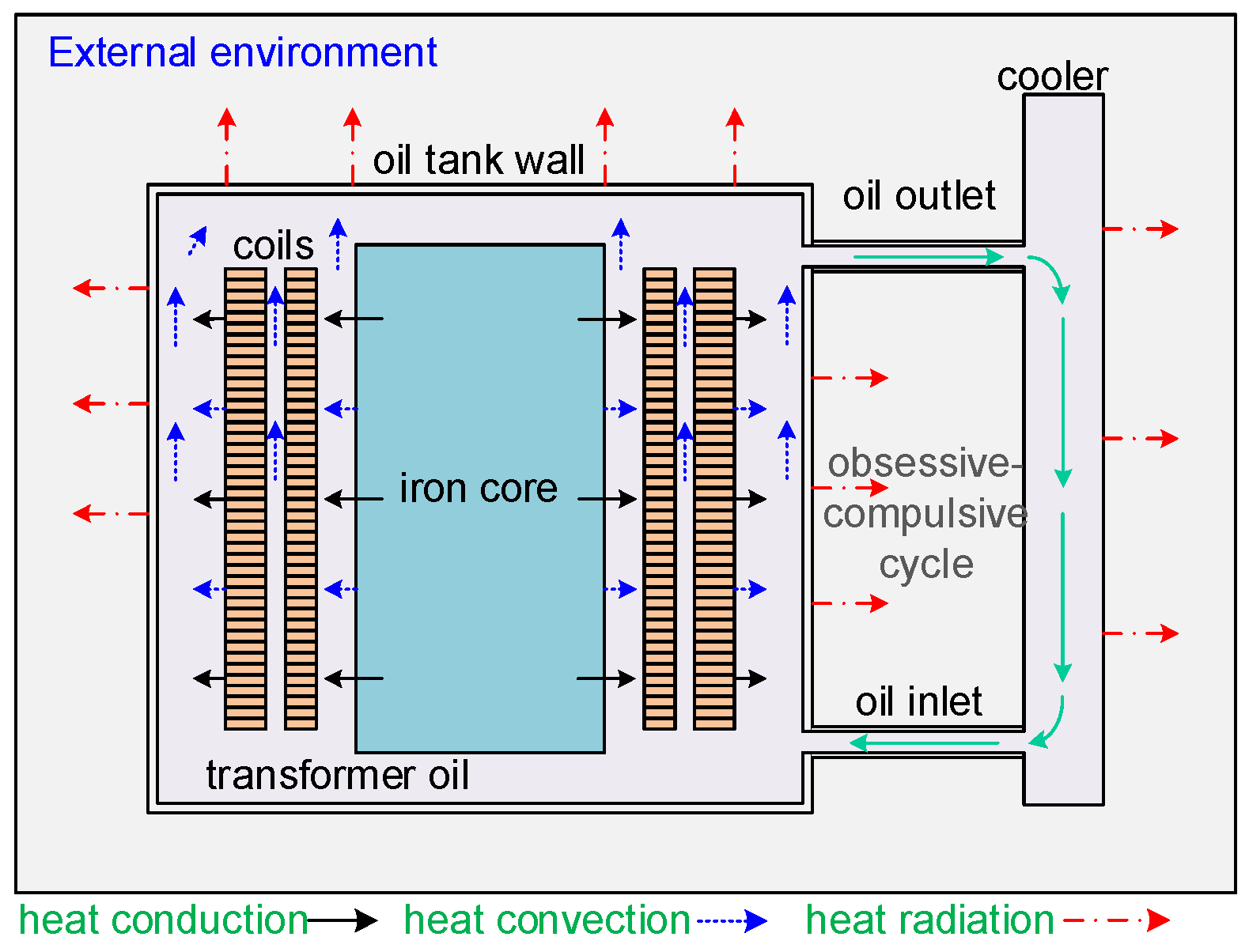
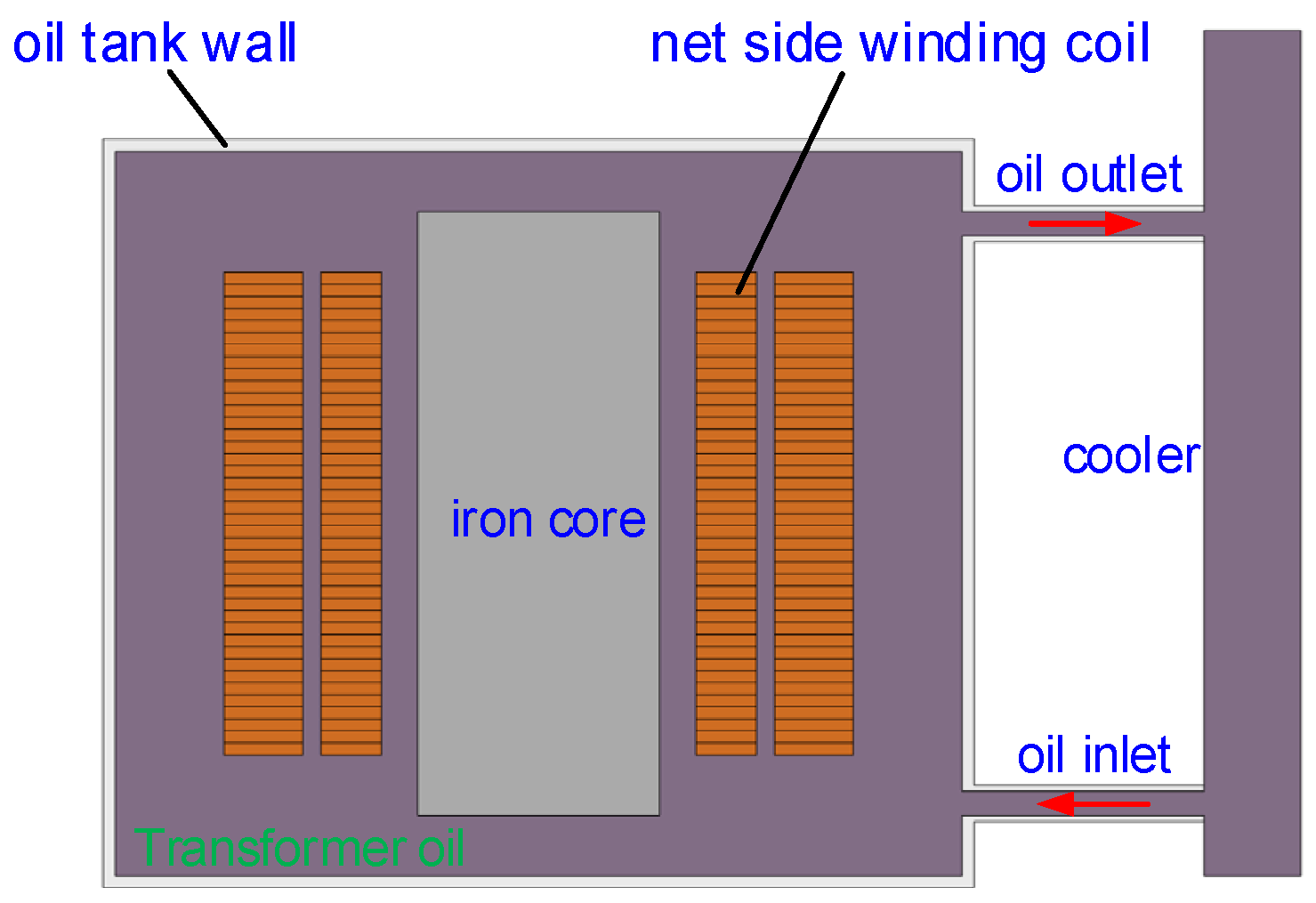
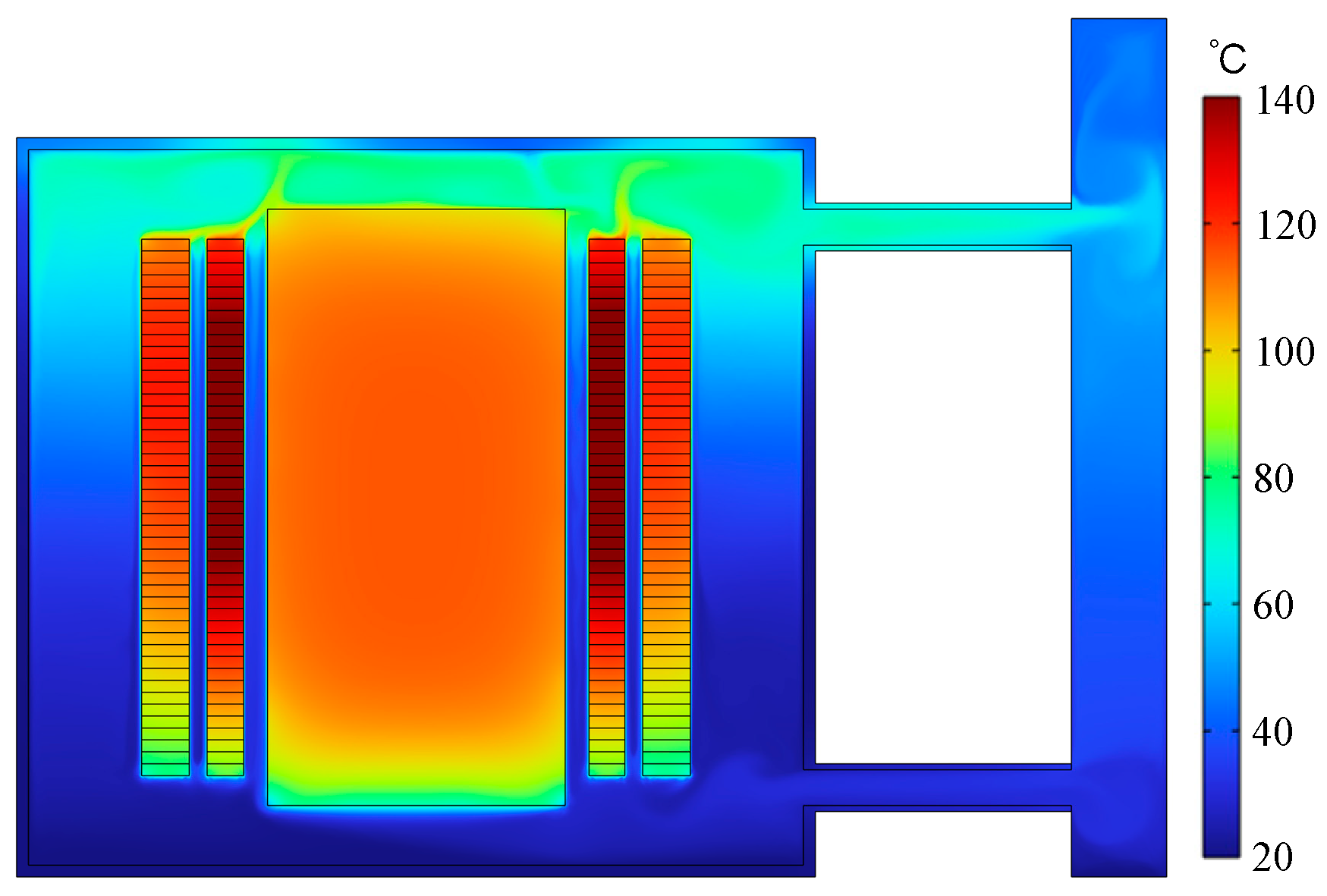
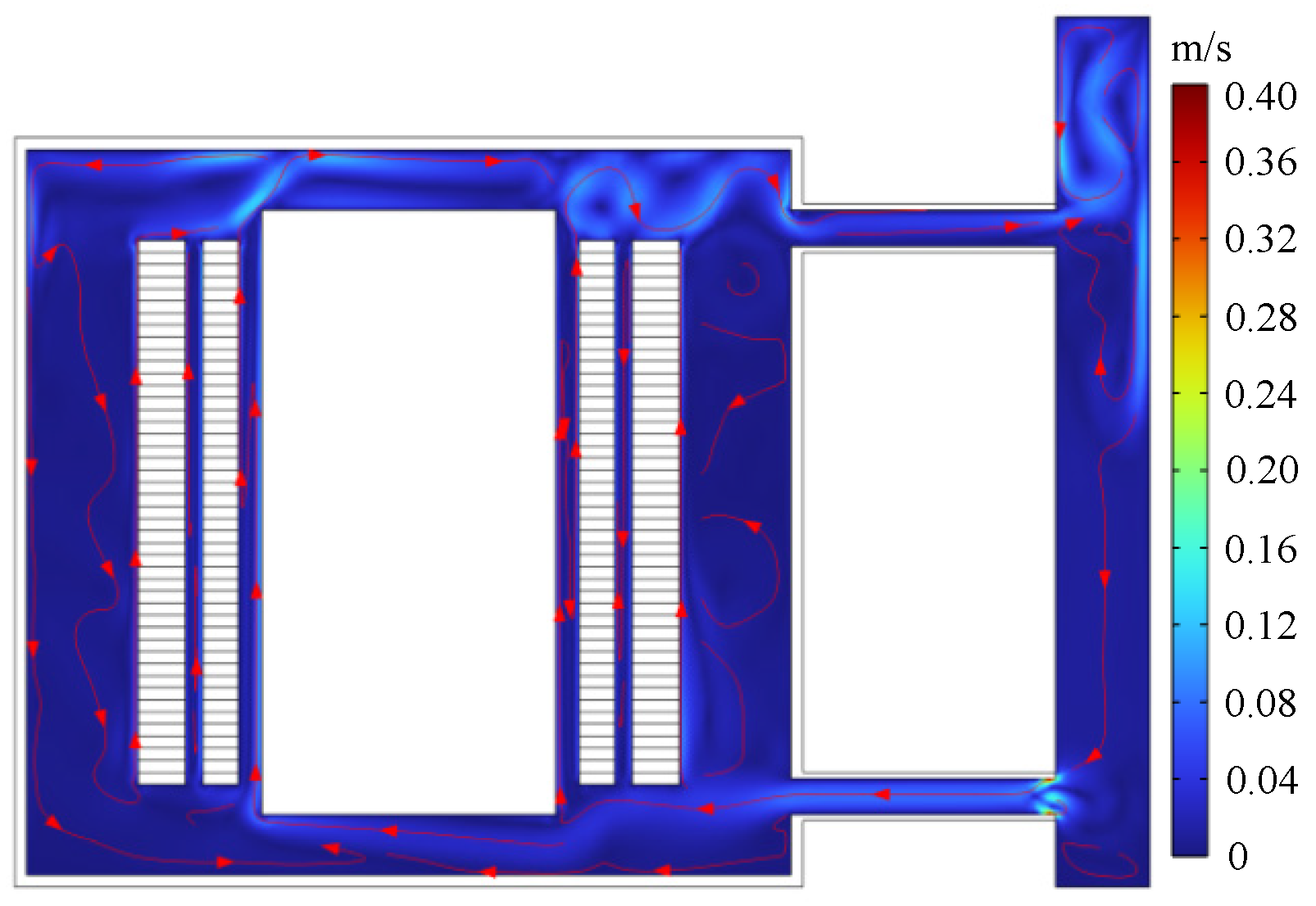
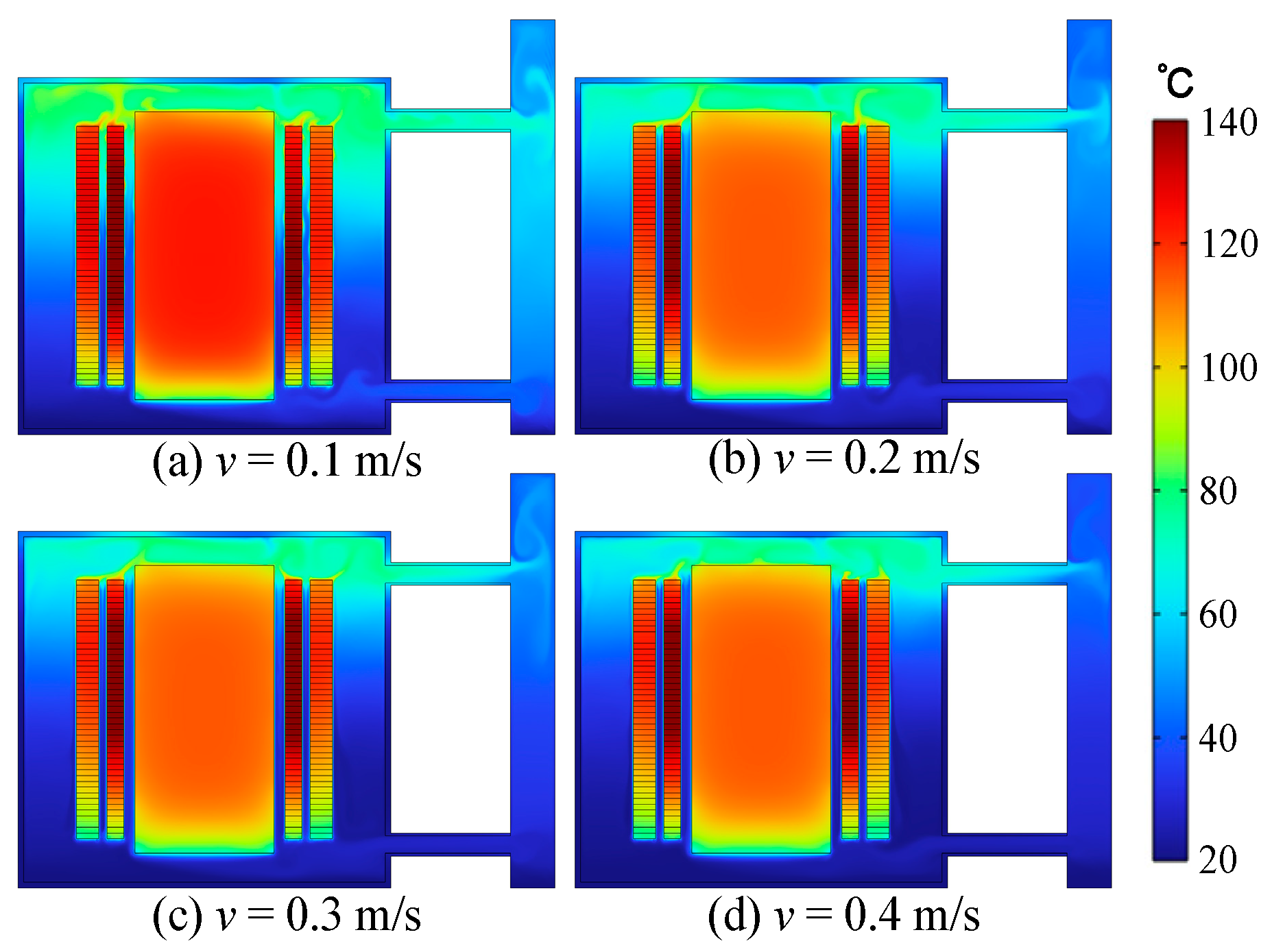
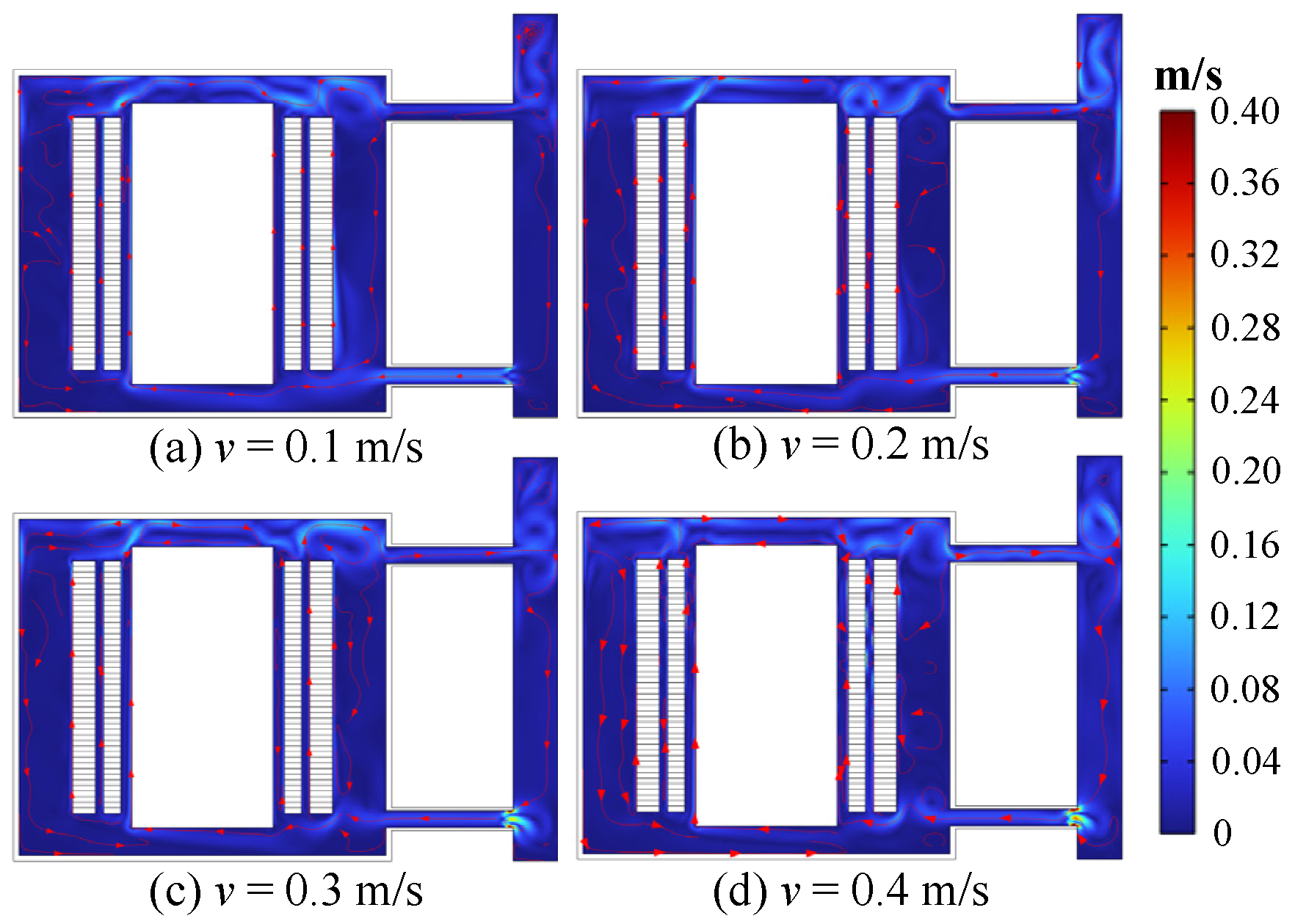
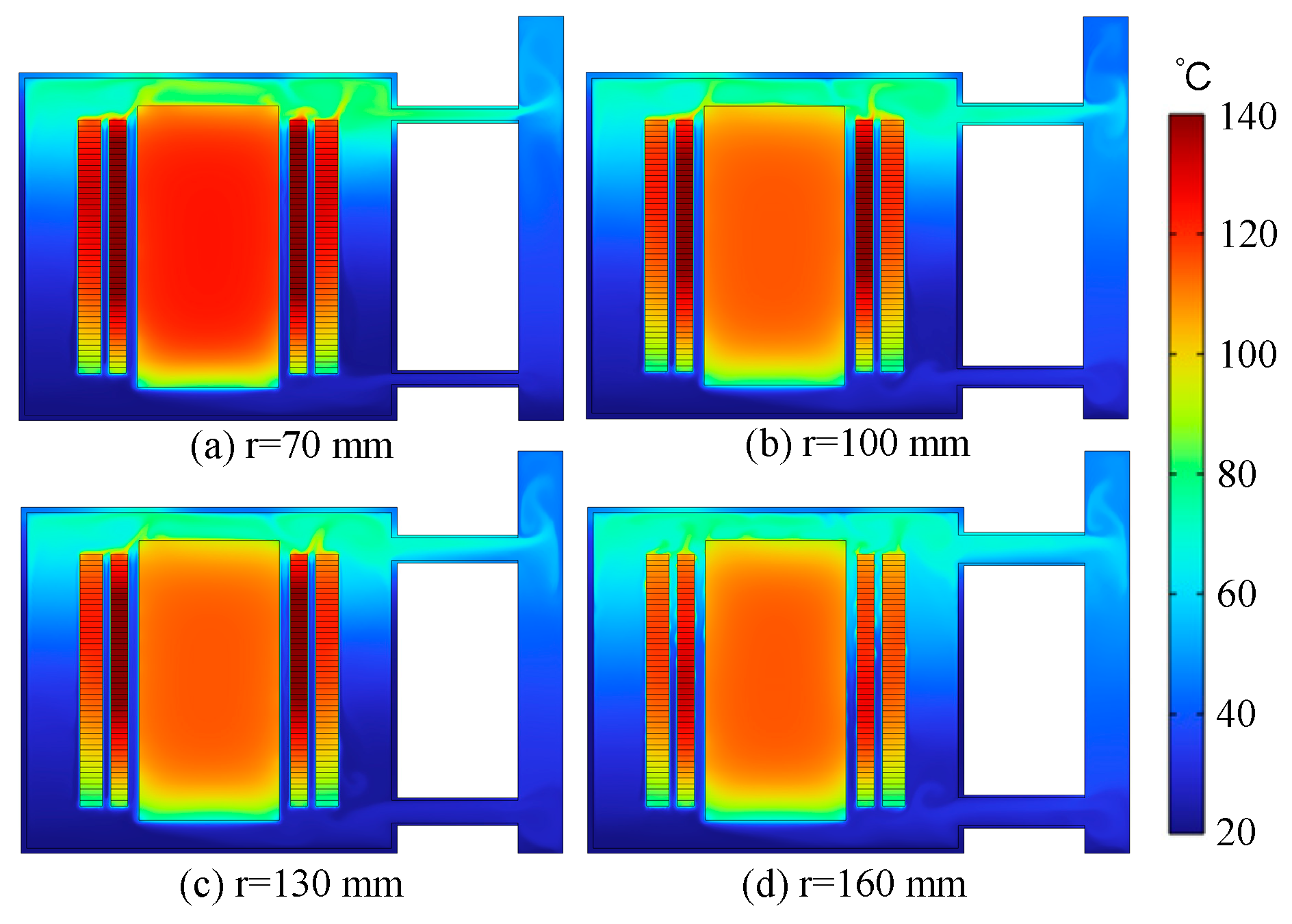
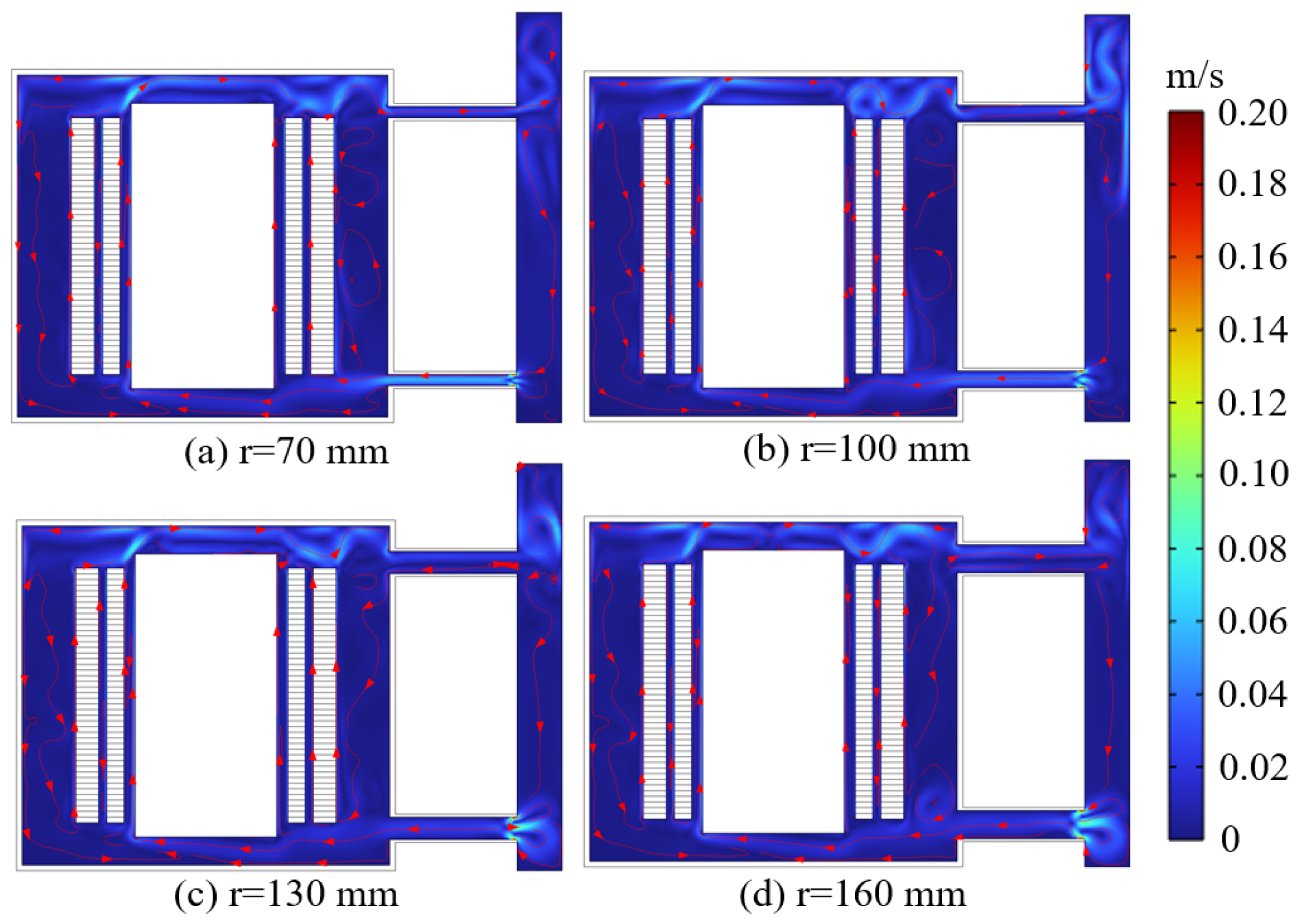
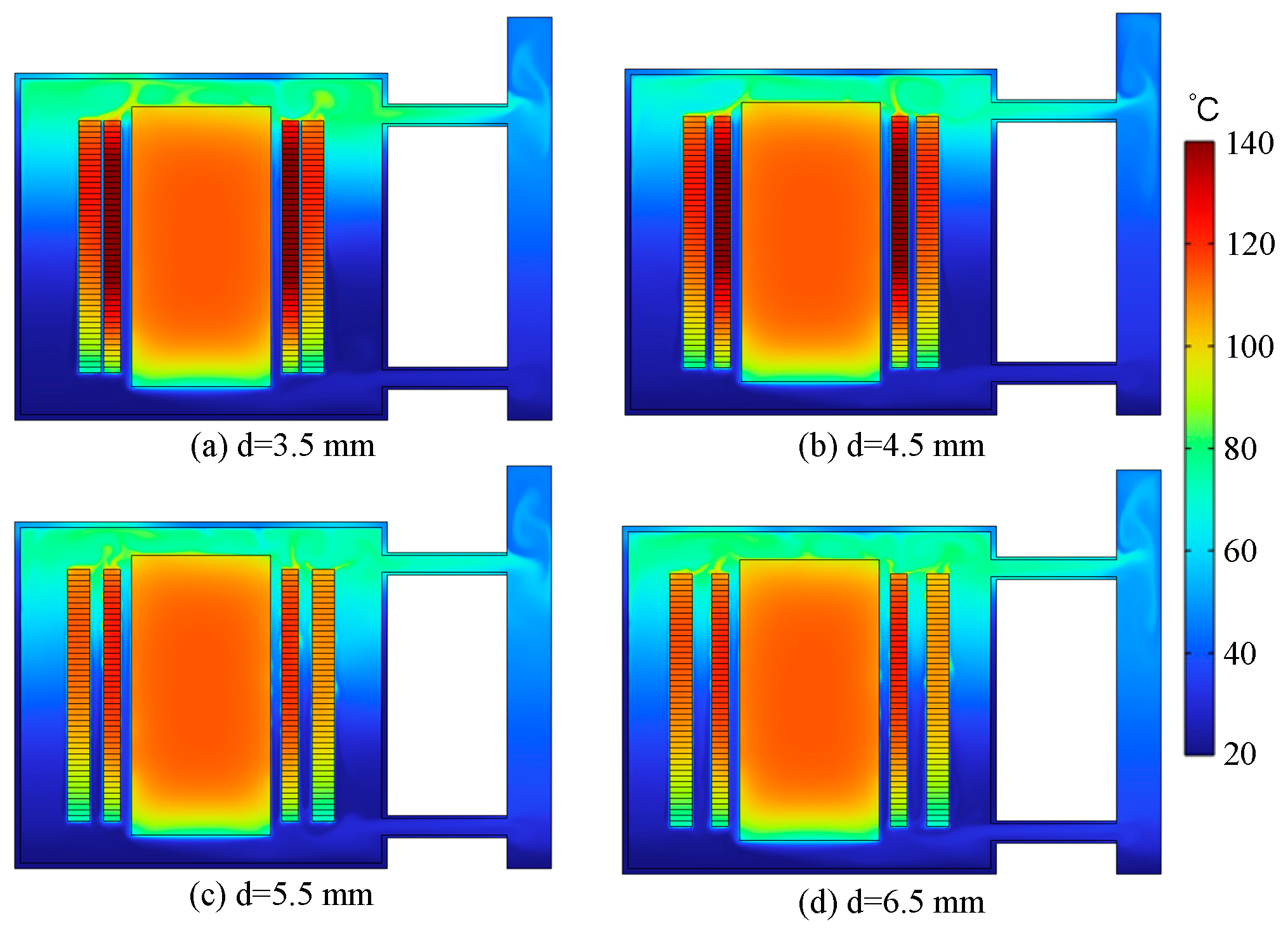
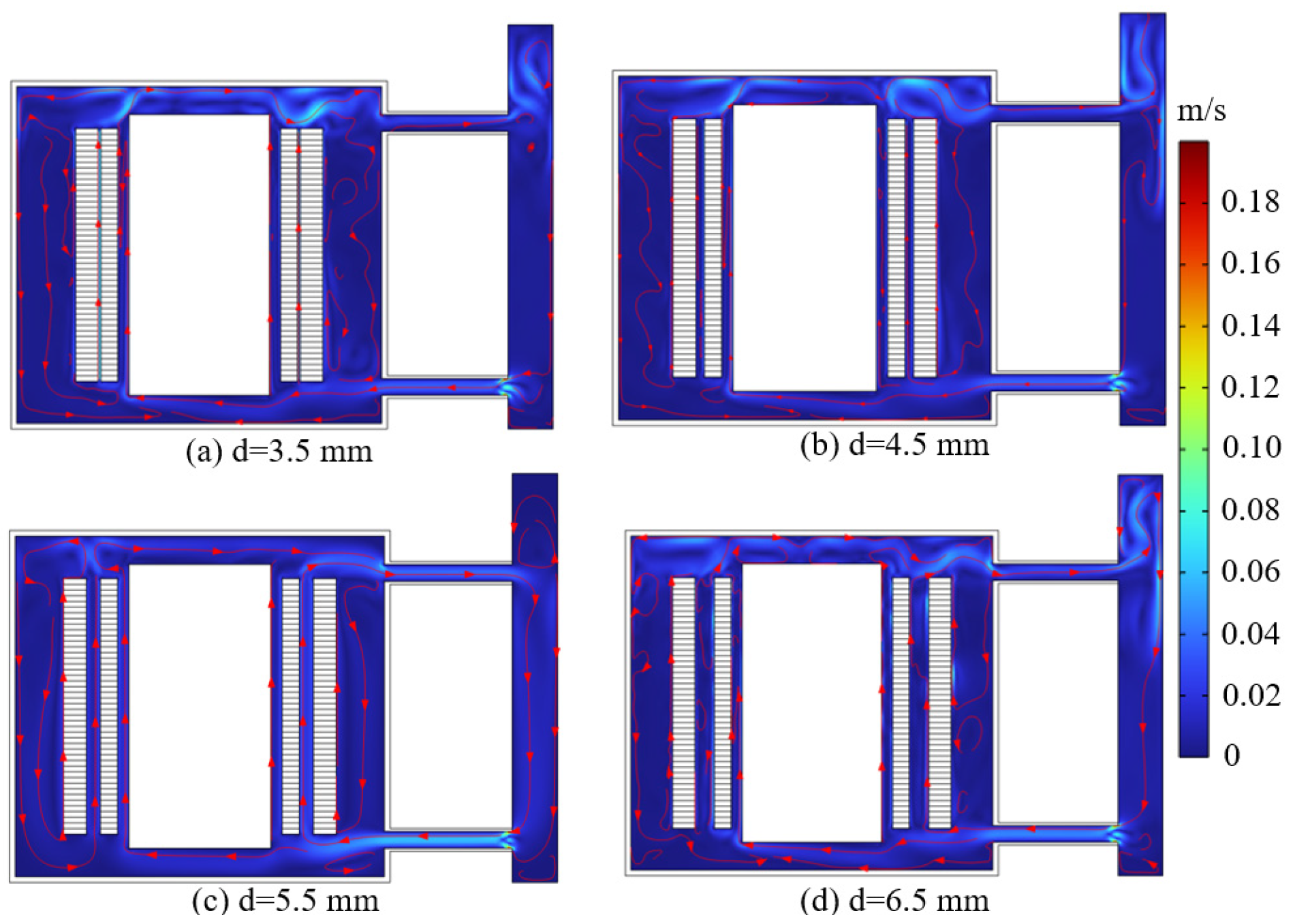



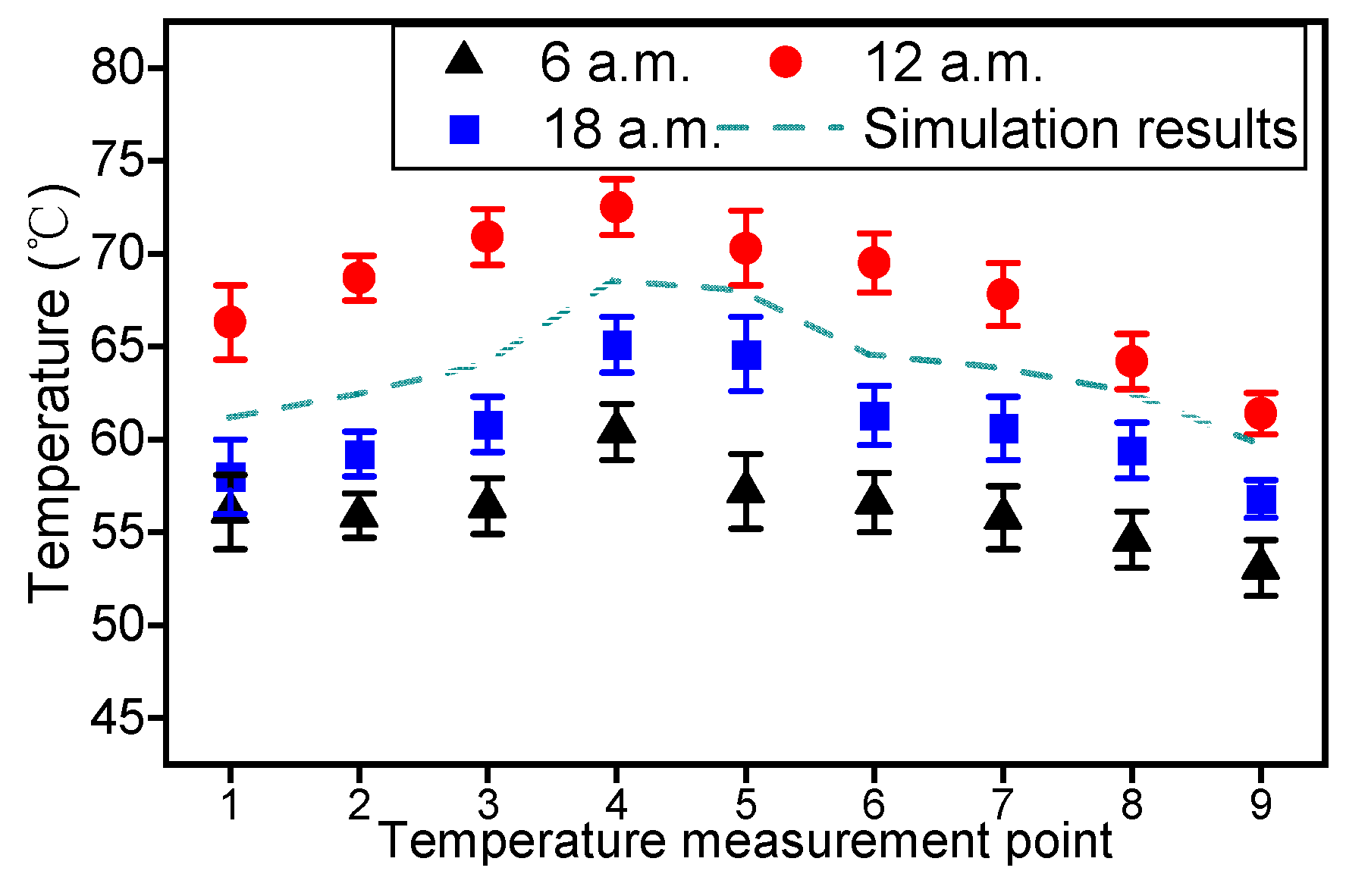
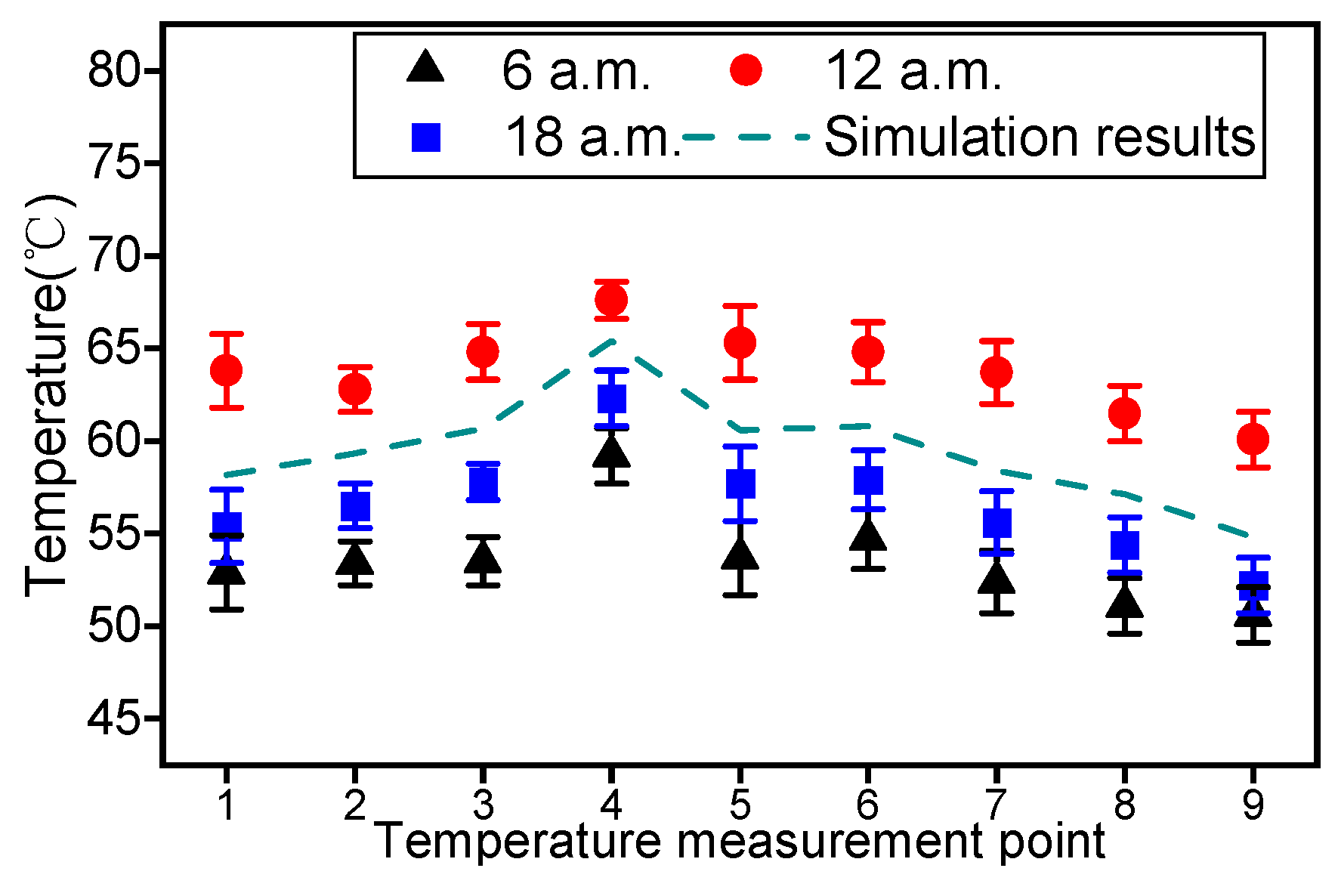
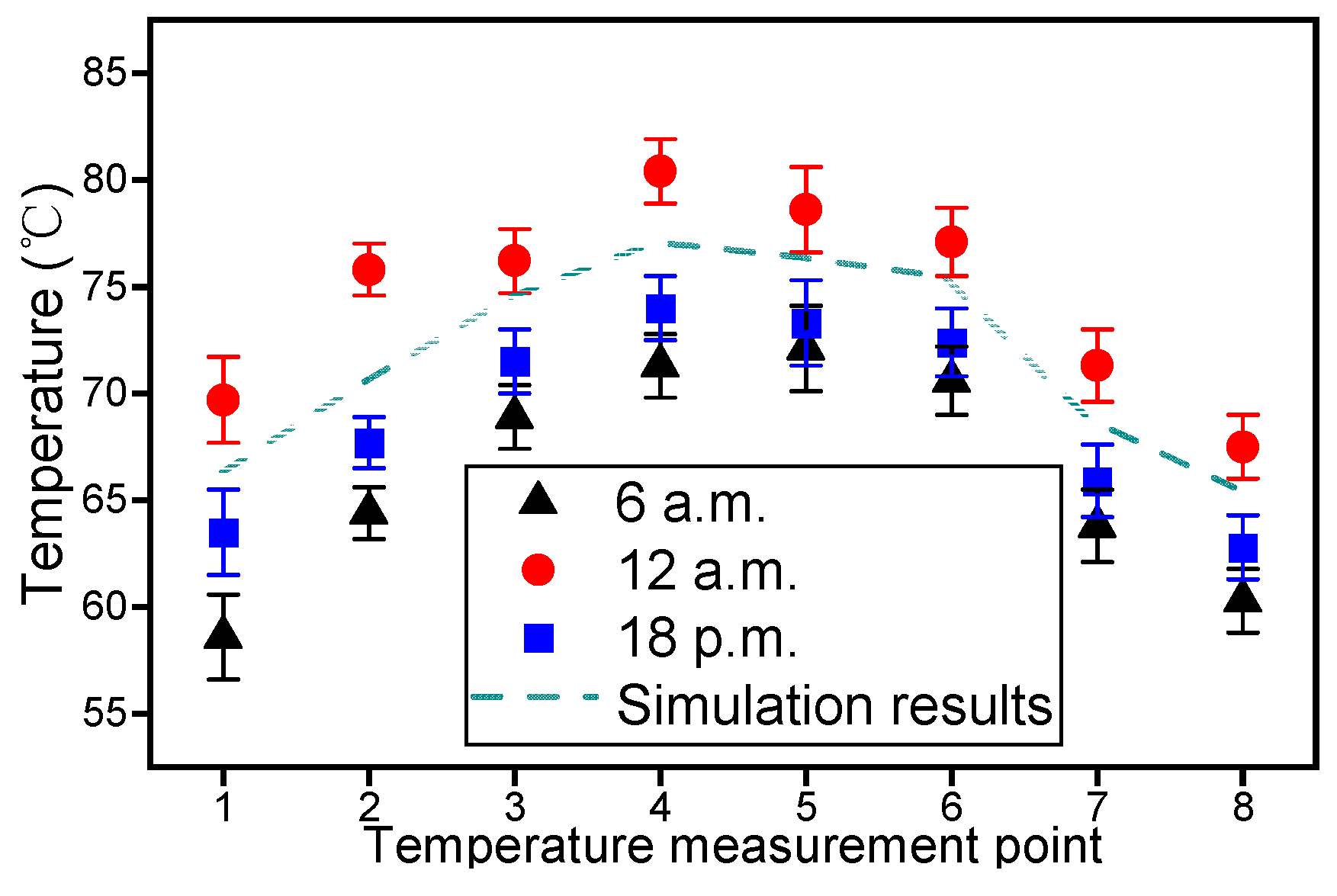
| Nomenclature | Abbreviation | |
|---|---|---|
| 1 | Ultra-high-voltage direct current | UHVDC |
| 2 | Temperature | T |
| 3 | Heat Flow velocity | v |
| 4 | Pipe radius | r |
| 5 | Density | ρ |
| Oil-Immersed Transformer Losses | ||
|---|---|---|
| Core Loss | Hysteresis loss | Change in the direction of the magnetic moment of the core |
| Eddy current loss | Self-excited loop included current | |
| Winding Losses | Resistance loss | Joule heat of winding resistance |
| Eddy current loss | Leakage field | |
| Material | Thermal Conductivity (W·m−1·K−1) | Constant Pressure Heat Capacity (J·kg−1·K−1) | Density (kg·m−3) |
|---|---|---|---|
| Silicon steel sheet | 72 | 446 | 7550 |
| Copper | 400 | 385 | 8940 |
| Non-magnetic stainless steel | 17 | 522 | 7880 |
Disclaimer/Publisher’s Note: The statements, opinions and data contained in all publications are solely those of the individual author(s) and contributor(s) and not of MDPI and/or the editor(s). MDPI and/or the editor(s) disclaim responsibility for any injury to people or property resulting from any ideas, methods, instructions or products referred to in the content. |
© 2025 by the authors. Licensee MDPI, Basel, Switzerland. This article is an open access article distributed under the terms and conditions of the Creative Commons Attribution (CC BY) license (https://creativecommons.org/licenses/by/4.0/).
Share and Cite
Zhou, Z.; Luo, C.; Zhang, F.; Zhang, J.; Yang, X.; Yu, P.; Liao, M. Thermal Management in 500 kV Oil-Immersed Converter Transformers: Synergistic Investigation of Critical Parameters Through Simulation and Experiment. Energies 2025, 18, 2270. https://doi.org/10.3390/en18092270
Zhou Z, Luo C, Zhang F, Zhang J, Yang X, Yu P, Liao M. Thermal Management in 500 kV Oil-Immersed Converter Transformers: Synergistic Investigation of Critical Parameters Through Simulation and Experiment. Energies. 2025; 18(9):2270. https://doi.org/10.3390/en18092270
Chicago/Turabian StyleZhou, Zhengqin, Chuanxian Luo, Fengda Zhang, Jing Zhang, Xu Yang, Peng Yu, and Minfu Liao. 2025. "Thermal Management in 500 kV Oil-Immersed Converter Transformers: Synergistic Investigation of Critical Parameters Through Simulation and Experiment" Energies 18, no. 9: 2270. https://doi.org/10.3390/en18092270
APA StyleZhou, Z., Luo, C., Zhang, F., Zhang, J., Yang, X., Yu, P., & Liao, M. (2025). Thermal Management in 500 kV Oil-Immersed Converter Transformers: Synergistic Investigation of Critical Parameters Through Simulation and Experiment. Energies, 18(9), 2270. https://doi.org/10.3390/en18092270





